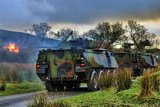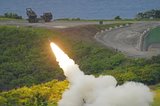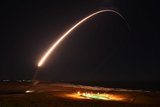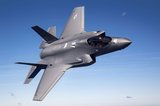North Korea begins dismantling rocket test site
North Korea has started dismantling some facilities at its main satellite launch station, seen as the testing ground for its intercontinental ballistic missiles, according to expert analysis of recent satellite images.
If confirmed, the analysis by US-based website 38 North could signal a step forward after the landmark summit between Kim Jong Un and US President Donald Trump in June 2018, although some experts questioned the significance of the gesture.
After the summit, Trump had declared the North Korean nuclear threat was effectively over, and US media reports suggest he is privately furious at the lack of any subsequent progress on the denuclearisation issue.
His public statements, however, remain upbeat and the 38 North analysis came as the president pronounced himself ‘very happy’ with the way talks were progressing with Pyongyang.
The website said imagery indicated the North had begun taking down a processing building and a rocket-engine test stand that had been used to test liquid-fuel engines at its Sohae Satellite Launching Station.
Sohae, on the northwest coast of North Korea, is ostensibly a facility designed for putting satellites into orbit, but rocket engines are easily repurposed for use in missiles and the international community has labelled Pyongyang's space programme a fig leaf for weapons tests.
38 North analyst Joseph Bermudez called the move an ‘important first step’ for Kim in fulfilling a promise that Trump said the North Korean leader made during their June 2018 summit in Singapore.
Since Sohae is ‘believed to have played an important role in the development of technologies for the North's intercontinental ballistic missile programme, these efforts represent a significant confidence-building measure on the part of North Korea,’ Bermudez said.
Trump said in Singapore that Kim had committed to destroying a ‘major’ missile engine test site, without specifying the site.
Sohae has been the North's main rocket launch site since 2012, and South Korea – whose president brokered the landmark summit between Trump and Kim – called it a step towards denuclearisation.
Nam Gwan-pyo, deputy director of the presidential national security office, told reporters: ‘It's a better sign than doing nothing. I believe they are moving step by step towards denuclearisation.’
But some experts cautioned against reading too much into the work described in the 38 North analysis.
Melissa Hanham, senior research associate with the James Martin Center for Nonproliferation Studies in Monterey, said that while dismantling the engine test site was a ‘good move’, it amounted to ‘the bare minimum’ that could be done at Sohae.
Hanham said on Twitter: ‘Unless they dismantle the whole site, it will remain North Korea's premier location for space launches. North Korea does not need the Sohae engine test stand anymore if it is confident in the engine design. As (Kim Jong Un) said himself, North Korea is moving from testing to mass production.’
Adding further Hanham said that observers should look for signs of new sites where more missiles could be built.
She said: ‘We ignored North Korea too long, and now it's about managing how many nuclear weapons and delivery systems they have, not if they have them.’
A US defence official also played down the news, saying the Sohae site was not a priority in terms of monitoring the North's denuclearisation efforts.
The official said: ‘It's not on the radar, so to speak.’
In a sign of Washington's impatience with what it sees as North Korean heel-dragging on the denuclearisation issue, US Secretary of State Mike Pompeo was in New York in the week of 16 July urging UN member-states to keep tough economic sanctions in place to pressure Kim into moving forward.
China and Russia have argued that North Korea should be rewarded with the prospect of eased sanctions for opening up dialogue with the US and halting missile tests.
South Korea has also pushed ahead with its reconciliation with the North since a landmark inter-Korean summit in April 2018.
Seoul's defence ministry said on 24 July that it was considering withdrawing some troops from the border Demilitarised Zone (DMZ) on a trial basis – a move which could expand into a gradual pullout later.
The 1950-53 Korean War ended with an armistice rather than a peace treaty, leaving the two Koreas technically at war. The DMZ was designated as a buffer zone but the areas to the north and south of it are heavily fortified.
At their April 2018 summit, Kim and the South's president Moon Jae-in agreed to cease all hostile acts and turn their border into a ‘peace zone’.
More from Defence Notes
-
![Taiwan approved for purchase of $11 billion in weapons from US]()
Taiwan approved for purchase of $11 billion in weapons from US
The US State Department’s approval of a multi-billion-dollar sale of weapons to Taiwan includes tactical mission networks equipment, uncrewed aerial systems, artillery rocket systems and self-propelled howitzers as well as anti-tank guided missiles.
-
![US National Security Strategy prioritises advanced military capabilities and national industry]()
US National Security Strategy prioritises advanced military capabilities and national industry
The 2025 NSS has emphasised investment in the US nuclear and air defence inventory and national industry, but it leaves multiple unanswered questions on how the White House will implement this approach.
-
![Canada set to look away from its neighbour and across the Atlantic for partners]()
Canada set to look away from its neighbour and across the Atlantic for partners
While non-EU UK struggles to join the Security Action for Europe initiative, which provides loans for defence programmes, Canada has become the first country outside Europe to get access – and did so for a nominal fee.
-
![NATO experiments with solutions to integrate networks, AI and uncrewed systems]()
NATO experiments with solutions to integrate networks, AI and uncrewed systems
During the latest edition of the NATO DiBaX, the alliance tested multiple capabilities to inform requirements for future efforts.
























